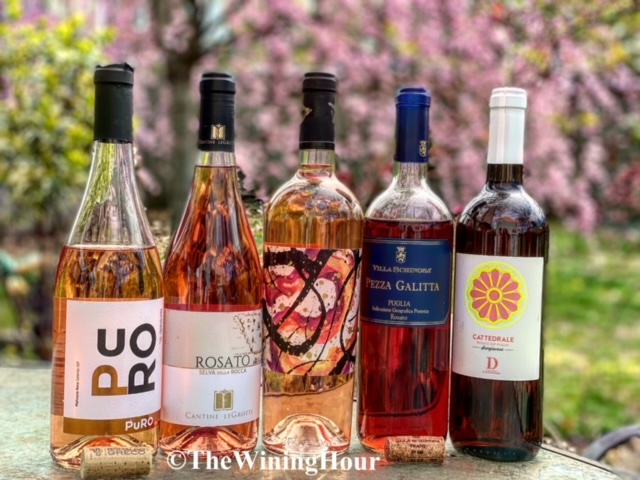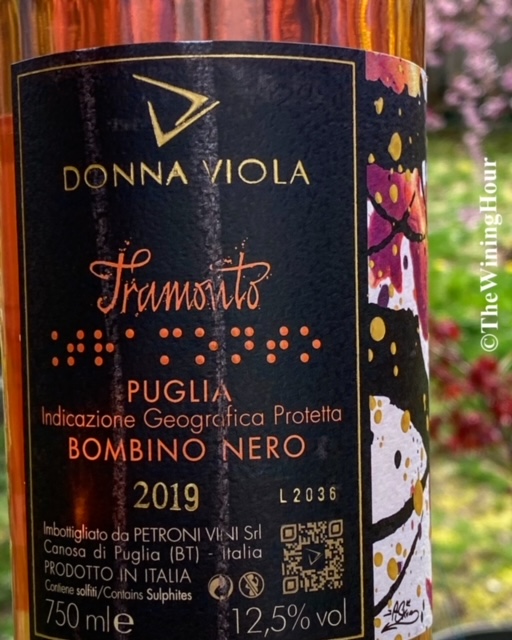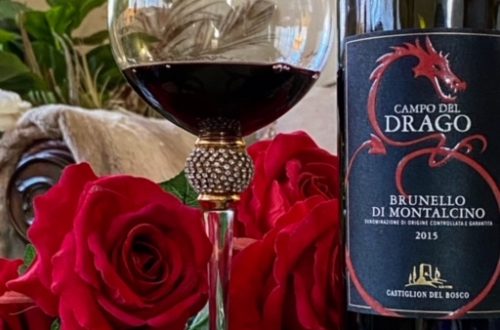
Peering Into the Pink Wines of Puglia
Rosé all day. While this phrase is catchy, it really is the sentiment shared by many. Although the pink wines known as rosé are very popular these days, rosé is one of the oldest types of wine made. Rosé wines are produced from a wide variety of grapes and can be found in just about every region of the world…including Italy. While there are a few regions noted for rosé, Puglia is one of Italy’s major producers of rosé. In fact, Puglia serves as a benchmark for Italian rosato or rosé. Rosé wine production was originally referred to in the 19th century as lacrimas, or delicate, fragrant tears of juice. Apulia adopted many techniques from the ancient Greeks, such as this one, and therefore, used the lacrima, or teardrop drip-pressing method, which required minimal skin contact.

Today, Puglia produces many fantastic rosato wines via the salasso method, by bleeding the tank or direct pressing. Puglia has almost 25 indigenous grapes, with several of them being used in the production of rosé (Nero di Troia, Bombino Nero, Negroamaro, Primitivo, Malvasia Nera, Susamaniello and Aglianico). Each grape, along with the Mediterranean climate, proximity to the Adriatic and Ionian seas and calcareous, clay soils, leads to a different style and color of rosé worthy of further exploration.
“For us, rose wine is not a mere consumer product but a real lifestyle. Its freshness and its bright color are a symbol of our local elegance.”
Association Puglia in Rosé
The Puglia in Rosé Association was established around 2015 to promote the unique and special wine production of rosé in the region of Puglia. Their goal is to educate about the different types of rosé and to highlight some of the best expressions of rosé produced in Puglia. The association does this by organizing educational events and preparing promotional activities aimed at trade in national and international markets.

The Wining Hour collaborated with Puglia in Rosé to host an informational tasting to raise awareness and promote the quality and enjoyment of rosato from Puglia. Therefore, we did not stick to the most popular or notorious Apulian rosatos. The tasting was designed to expose and highlight other, lesser known regional rosés. As rosé is a pretty big category in Puglia, the featured rosés were to serve as a benchmark. I have been to Puglia several times, but the focus has usually been on Puglia’s red wines. Having the opportunity to delve more deeply into the regions rosé wines was very exciting. Warmer weather is coming, and its a great time to learn more about rosés from Italy.
The Association Puglia in Rosé endeavors to: “qualify the image of Puglia’s rosé wines as Made in Italy products of excellence, promote business opportunities abroad for Apulian operators and give impetus to the international promotion activities of the Puglia brand.” Read on to see what we tasted.

THE WINING HOUR WITH PUGLIA IN ROSÉ
Romaldo Greco, Puro Salento IGP Rosé 2019
Azienda Agricola Romaldo Greco is located in Secli, near Lecce, and was founded in 1973. We were able to speak with Gloria Greco, daughter of Romaldo Greco, who discussed more about their wine production. Their mission is “Quality. First, along with passion, tradition and innovation.”

Puro Rosé is 100% Malvasia Nera. Puro is a pale pink with orange flecks, as it is only left on the skins for two hours. The wine is aged for four months in stainless steel and one month in bottle before release. Puro is a bright rose, with soft, fresh delicate cherry, apple and floral (elderberry)notes. The clay, alkaline soil, along with the winery’s proximity to the Ionian and Adriatic Seas contribute hints of minerality. Puro is structured, with layers of flavor being revealed with every swirl. Very well-balanced. 12.5% ABV.
Puro, pure or clean, in Italian, is what this wine is all about. Puro represents varietal purity, and the winery conveys this with the clean, young, smart and simple wine label. Interestingly, Romaldo Greco uses special zero-carbon-footprint corks derived from sugarcane-based raw materials. These Nomacorc corks are designed to avoid problems such as faults and flaws associated with oxygenation and natural corks. Instead, Normcorc sugarcane corks, which are sustainable, renewable and recyclable, help to preserve the natural flavors and aromas of the wine.
Gloria Greco mentioned that Romaldo Greco wines want to “emit the passion, patience and love of her family.” Puro is a lovely example.
Donna Viola Tramonto Rosé IGP 2019
The Donna Viola Winery was created by Petroni Vini. With this new line of wines, they wanted to create a new identity, more authentic and a “made in Apulia” feel.
“Every bottle tells a nuance of this fascinating region…a glass of Donna viola is a glass of Apulia.”
Donna Viola
Donna Viola Tramonto Rose, made from 100% Bambino Nero, is a medium salmon color and is left on the skin for a maximum of two hours. Tramonto is quite aromatic, with fresh aromas of citrus fruit, as well as red fruit (wild strawberry and raspberry) and flower nuances (violet, rose). Tramonto is fresh, fragrant and full bodied with good sapidity and bright acidity. 12.5% ABV.

Tramonto, which means sunset in Italian, has all of the ingredients of a warm summer evening. In fact, the bottle design even reflects the colors of a sunset. The colors were carefully chosen, as color “is the protagonist of this project that gives substance to abstraction.” All of Donna Viola’s wine bottles labels were designed by an artist to represent and depict the cyclical phases of the day. The logo forms an open triangle to represent harmony. The winery also maintains that the open triangle is “an open and interrupted shape that represents challenge, undertaken with passion, courage and sense of innovation.
While the beautiful artwork on the bottle label stands out, something else is noteworthy: there is braille on the labels. Donna Viola, in partnership with UICI-Italian Union of Blind and Partially Sighted People, manufactures their wines with codified language labels for the blind. According to Marie Viola, “Wine is not a luxury drink, but a moment to share with everyone.” Therefore, this is a major attempt by the winery to break down barriers. What a fantastic way to share their wine and promote inclusion!

Villa Schinosa Pezza Galitta Puglia IGP Rosato 2019
“Innovation, Tradition and Passion“ are valued at Villa Schinosa.
This is a very interesting Rosato, given the fact that it blends two powerful grapes. Villa Schinosa Pezza Galitta brings together Bombino Nero (70%) and Aglianico (30%). This wine, left on the skins for approximately 12 hours, is a deep pink, with intense fruity aromas. Wild cherry, violet and strawberry. It is very smooth on the palate with undeniable freshness and lots of mineral notes due to the tufo-limestone soil. Marked sapidity. As Bombino Nero and Aglianico are grapes with great potential, this is an age worthy rose.
12% ABV. Pezza Galitta would pair nicely with antipasto.

Cantine d’Alessandro Cattedrale Rosato Puglia IGP 2019
We talked with siblings Angela and Giovanni (winemaker) of Cantine d’Alessandro, where their story is “Una storia in continua evoluzione,” where their story continues to evolve. They began in the bottling industries and later became wine producers. Today, Cantine d’Alessandro has vineyards in north and south of Italy. This could be why their featured Rosato is made from one of Italy’s most well-known and widely-planted grapes.
Cattedrale is made from 100% Sangiovese.
After harvesting, the grapes spend 6-8 hours of skin contact. This Rosato is light, fruity and floral. Cherry flavors typical of Sangiovese.
Persistent with 12.5% ABV. According to the winemaker, this rosato was crafted to be “young and fresh, and to attract younger people.” This wine, Cattedrale, as well as the names of their other wines (Cantoria, Ardente, Opera), all seem to have a religious connection. Giovanni explained that it certainly was intentional due to their territory and strong connection to their Catholic faith.
Cantine Le Grotte
Cantina Le Grotte, located in Apricena, Foggia, was founded in 2014 “to recoup the centuries-old winemaking tradition characterizing the territory of Fondo Grotte. The farming estate is owned by the Gruppo Franco Dell’Erba, a stone extraction firm. Biago Cruciani, Manager at Cantine Le Grotte, provided a little more information about the estate and their winemaking.
Typical of the karst landscape in Puglia, Cantine Le Grotte’s estate is rooted in calcareous soil formations, rich in minerals, like the apricena stone. Distinctive minerality is the most important feature. They are also surrounded by the Lesina lagoon that provides for intense aromas in the wines. This tasting included both a rosato and a white wine.

“Our wines: sincerity, elegance, excellent balance.”
Cantine Le Grotte Selva Della Rocca Nero di Troia Rosato Puglia IGP 2019
Selva Della Rocca, which translates to save the rocks, is connected to the stone extraction and Fondo Grotte (deep caves) winemaking tradition associated with the region of Apricena. As a result of its excellent soils and pleasant climate, the area is known for its wine. It is also famous for its marble quarries.
Selva della Rocca is 100% Nero di Troia. This wine is deep pink in appearance, with a persistent bouquet. Hints of red berries (cherry, pomegranate) and the palate is delicate and pleasant. 12.5% ABV.
Cantine Le Grotte Sico Bombino Bianco Puglia IGP 2019
Bombino Bianco is normally suited for sparkling wines, which Cantina Le Grotte makes via the Charmat Method. However, this is a nice still wine presentation of Bombino Bianco. Sico is bright yellow with hints of green. Citrus fruit aromas, with grapefruit, white peach and floral notes on the palate. Excellent minerality. Fruity, but very fresh. Balanced acidity. 13% ABV. Delicious with fish.
“Sico” also references the ancient wine making tradition of Fondo Grotto. The Moneta Longobardo coin with Sico monogram is featured on the label. All of Cantine Le Grotte’s wine label reflect their terroir and historic reputation.
*This was the only white wine we tasted, but it was included by the producer to highlight the grape and the region. Bombino bianco is also a grape with great potential and aging capability.

Importers are welcomed. Contact the Association Puglia in Rose or the respective wineries for more details.

Related Articles from The Wining Hour:








